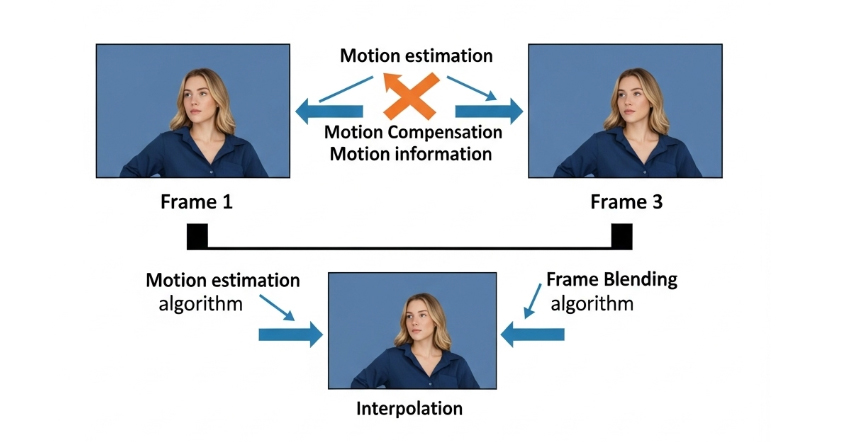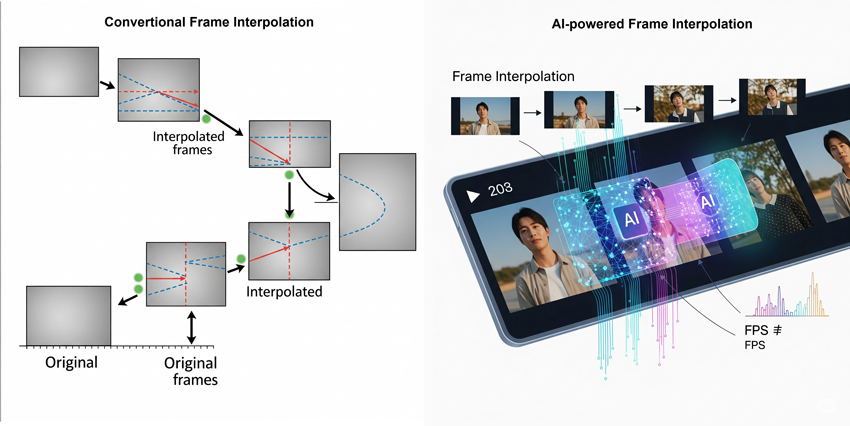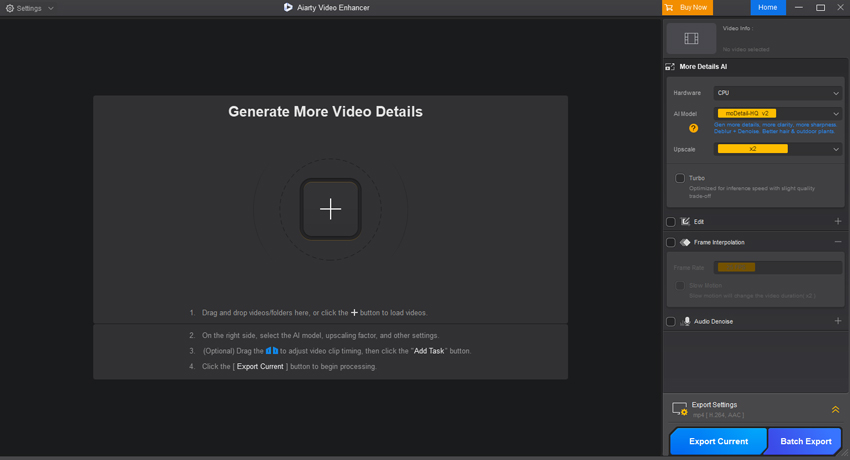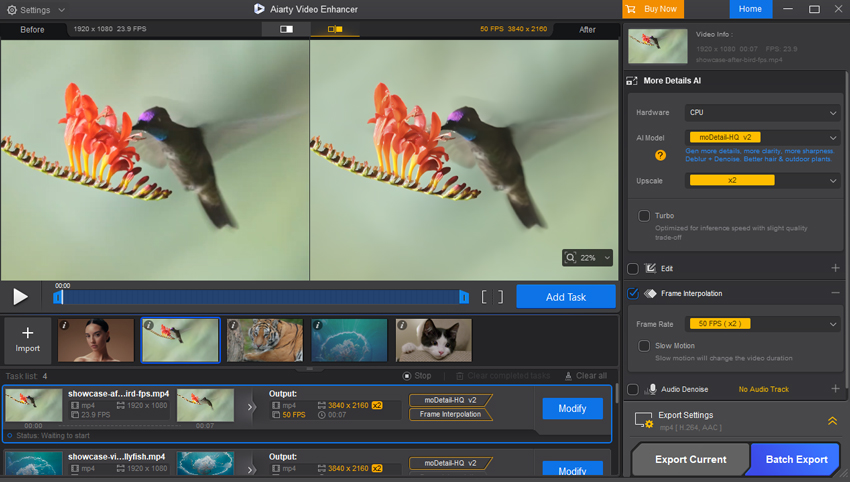Frame Interpolation Explained: A Complete Guide to Smoother, High-FPS Videos
Choppy motion, low frame rates, and stuttering playback can seriously impact video quality—especially in slow-motion footage, gameplay recordings, or old film restorations. Frame interpolation solves this by generating additional in-between frames, resulting in smoother, more lifelike motion. With the rise of AI, this technology has become faster, smarter, and easier to use than ever. In this article, we'll break down what frame interpolation is, how it works, and why it's changing the way we approach video editing. You'll also discover how today's best frame interpolation software lets you produce ultra-smooth, high-quality videos in just a few clicks.
What is Frame Interpolation
Frame interpolation is a video processing technique that increases a video's frame rate by generating new frames between existing ones. Instead of duplicating frames or relying on simple blending, interpolation algorithms analyze motion between two frames and intelligently create intermediate frames to smooth out transitions. The result is a more fluid and natural-looking video, especially noticeable in fast-moving scenes or when converting footage from 24fps to 60fps or higher. Originally used in TVs to reduce motion blur, frame interpolation is now widely applied in video editing, slow-motion effects, animation, and restoration—especially with the help of AI-powered tools that produce more accurate and realistic results.

How Does Frame Interpolation Work
Frame interpolation is a complex process that involves estimating the motion between two consecutive frames and synthesizing one or more intermediate frames to create smoother motion. At its core, the technique relies on motion estimation algorithms, most commonly optical flow, which tracks the displacement of pixels across frames. Optical flow attempts to determine the direction and velocity of every pixel as it moves from one frame to the next. Once this motion vector field is calculated, the system can predict how objects would appear in the intermediate time points, generating new frames accordingly.
Traditional interpolation methods often struggle with occlusions, rapid motion, or scene changes, which can lead to artifacts such as ghosting, warping, or temporal inconsistencies. Modern solutions leverage AI and deep learning models—trained on thousands of hours of video footage—to better understand spatial and temporal relationships. These models, such as convolutional neural networks (CNNs) or transformer-based architectures, can more accurately reconstruct fine details, handle complex motion patterns, and minimize artifacts.

Some advanced systems also integrate multi-scale analysis, context-aware synthesis, and edge-preserving techniques to enhance the realism of interpolated frames. The result is a significantly higher-quality video output, especially when converting low frame rate footage (e.g., 24fps) to higher frame rates like 60fps or even 120fps, enabling smooth playback and visually engaging slow-motion sequences.
Why AI-Powered Frame Interpolation Is a Game-Changer
AI-powered frame interpolation represents a significant leap forward from traditional techniques by dramatically improving accuracy, efficiency, and visual quality. Conventional methods, such as linear blending or basic optical flow, often produce artifacts like ghosting, jitter, or motion distortion—especially in scenes with complex motion, low light, or occlusions. In contrast, AI-based models leverage deep neural networks trained on large-scale video datasets to better understand motion dynamics, object boundaries, and context. This allows them to generate highly realistic in-between frames with superior temporal consistency and detail preservation. AI also enables automation of the entire process, reducing the need for manual tweaking and making high-quality frame interpolation accessible to both professionals and casual users. Furthermore, many AI-powered tools, such as Aiarty Video Enhancer, integrate interpolation with upscaling, denoising, and stabilization—delivering cinematic results in a single, streamlined workflow. As a result, AI has transformed frame interpolation from a niche editing technique into an essential tool for video enhancement, restoration, and creative storytelling.
Applications of Frame Interpolation
Frame interpolation has a wide range of applications across both professional video production and everyday content creation.
One of its most popular uses is in slow-motion video, where interpolated frames help convert regular footage into ultra-smooth slow-mo sequences without noticeable stutter. It's also widely used in frame rate conversion, allowing videos shot at 24fps or 30fps to be converted to 60fps or higher for modern displays, resulting in a more fluid viewing experience.
In video restoration, especially for old or damaged footage, frame interpolation helps reconstruct missing or corrupted frames, breathing new life into archival material. Gamers and streamers use it to enhance gameplay recordings, making action scenes look smoother and more professional.
Additionally, it plays a key role in animation and CGI workflows, where artists use interpolation to generate in-between frames, significantly speeding up production. With the rise of AI-powered solutions, frame interpolation is now also accessible to mobile editors, educators, and marketers looking to polish their videos with minimal effort.
Aiarty Video Enhancer: The Best Frame Interpolation Software
Aiarty Video Enhancer stands out as one of the leading frame interpolation tools available today, thanks to its powerful AI-driven technology and user-friendly design. Its advanced AI-powered frame interpolation module seamlessly transforms stuttering or low-frame-rate videos into silky-smooth footage by enhancing them to 90fps, 120fps, or even higher. Leveraging AI-trained flow estimation alongside sophisticated motion compensation algorithms, Aiarty generates intermediate frames that are both natural and visually consistent, effectively eliminating common artifacts such as jello effects, smearing, and frame distortion. This versatility makes it the perfect solution for a wide variety of video types—including fast-paced live action, timelapse, slow-motion sequences, animation restoration, 3D CGI renders, and AI-generated films. Regardless of the original footage, Aiarty delivers smooth, coherent visuals with professional-grade quality, bringing every frame vividly to life.
How to Interpolate Frame Using Aiarty Video Enhancer
Step 1. Download and install Aiarty Video Enhancer, then launch the program on your computer.
Step 2. Import your video files or an entire folder by simply dragging them into the main workspace. Aiarty supports a broad range of video formats, so most standard and high-definition files are compatible.

Step 3. Select the video you want to process and navigate to the properties panel on the right. Enable the Frame Interpolation feature, then choose your desired output frame rate—such as 60fps, 90fps, or 120fps. Next, click the Preview button located beside the preview window. Aiarty will automatically generate a real-time preview using the default AI upscaling and interpolation settings.

Step 4. Once you are satisfied, go to the Export Settings panel and click "Export Current" to begin processing and save your enhanced video with the newly interpolated frames.
Other Frame Interpolation Software
1. Adobe After Effects
Adobe After Effects offers frame interpolation through its Time Interpolation and Pixel Motion features, allowing users to generate smooth slow-motion effects or retime footage by creating in-between frames. It uses optical flow technology to estimate pixel movement between frames, which can be effective in simple motion scenes. However, the results often require manual tweaking, and performance may degrade in fast or complex sequences. While powerful for professionals already using Adobe's ecosystem, it lacks the automation and AI enhancements found in newer interpolation tools.
2. Topaz Video AI
Topaz Video AI delivers high-end frame interpolation powered by advanced deep learning models. Its Chronos AI model is specifically designed to generate new frames for slow motion or frame rate conversion with minimal artifacts. Users can choose target FPS, control motion sensitivity, and preview results before exporting. While it provides some of the best quality in the market, the software is resource-intensive and best suited for users with powerful hardware and experience in video enhancement workflows.
3. Dain-App
Dain-App (Depth-Aware Video Frame Interpolation) is an open-source tool that uses a deep neural network to interpolate frames based on motion and depth estimation. It's widely appreciated in the enthusiast community for producing smooth slow-motion videos and decent interpolation results, especially for anime or simple live-action clips. However, the setup process can be complicated, requiring technical knowledge and specific hardware configurations. Despite its learning curve, Dain-App remains a strong choice for users seeking a free, AI-based interpolation solution.
Learn More: How to Use Davinci Resolve Frame Interpolation for Smoother Video
Frame Interpolation Software Comparison
 FAQs
FAQs
Yes, most video types can benefit from frame interpolation, especially those with noticeable motion stutter, low frame rates, or slow-motion intent. Aiarty supports a wide range of formats and works well with live action, timelapse, animation, and CGI footage.
Traditional methods may struggle with motion artifacts, but Aiarty Video Enhancer uses AI-trained motion estimation to produce smooth, artifact-free results—even in scenes with complex or fast motion.
Aiarty is optimized for GPU acceleration, so a mid-range system with a dedicated graphics card will deliver the best performance. However, its offline processing also makes it accessible to users without top-tier hardware.


